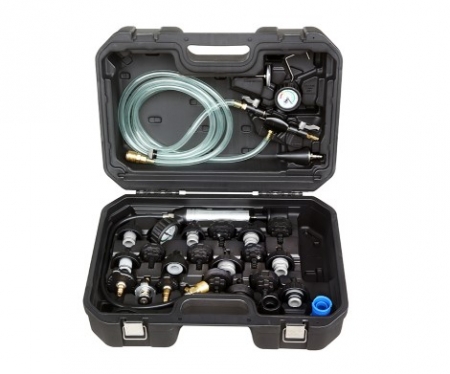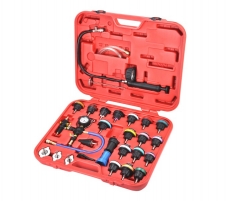Cooling System Leakage Tester and Vacuum-Type Coolant Refiling Kit 23PCS/SET
Model
KA-5580
Specification:
- Pressure pump to test leaks in cooling system
- Provided with 3 twist-on type and 16 threaded type adapters, covering almost all types of car makes and models on the market
- Vacuum-type coolant refill tool has large internal passages to allow coolant to be refilled fast
- Radiator cap test tubes (black and blue) to test if the radiator cap from the car has leaks
- Coolant hose and drain hose are made of cold-resistant material
- Application: Alfa, Romeo, Audi, BMW, Buick, Cadillac, Chevrolet, Chrysler, Citroen, Dodge, Fiat, Ford, GMC, Honda, Hyundai, Jaguar, Kia, Land Rover, Lincoln, Mazda, Mercedes Benz, Mitsubishi, Nissan, Opel, Peugeot, RAM, Renault, SEAT, Skoda, Saab, Subaru, Tesla, Toyota, Volvo, Vokswagen
COOLING SYSTEM LEAK TEST
.jpg)
.jpg)
.jpg)
.jpg)
- Remove the original cap
- Choose a suitable adapter
- Connect the adapter and the pressure pump
- Pump pressure to 10-15 psi (Fig 1)
- Rest for at least 15 minutes
- Check to see if the pointer on the gauge falls.
- If it falls, there are leaks in the cooling system
- Jack up the car and drain old coolant
- Choose a suitable adapter or the conical adapter
- Hang the tool under the hood
- Connect the adapter to the cooling system, and connect the tool’s coolant hose
- Put the hose with filter in the premixed coolant, and remain submerged under the surface the whole time
- Make sure all valves are closed and connect to air compressor
- Open the air valve and vacuum can be created (Fig 2)
- When no more vacuum can be created, turn off the air valve
- Open the coolant valve, and the coolant will be introduced to the cooling system automatically (Fig 3)
- Verify the coolant level, connect the original cap.
- Fast refill and no air bleeding.
- Connect the radiator cap to the blue or black tube
- Connect a suitable adapter on the other side
- Pump the pressure that is higher than what is specified on the cap to see if the cap can release pressure (Fig 4)
- Pump the pressure that is lower than what is specified on the cap to see if the cap can hold pressure.
.jpg)
.jpg)
.jpg)
.jpg)




